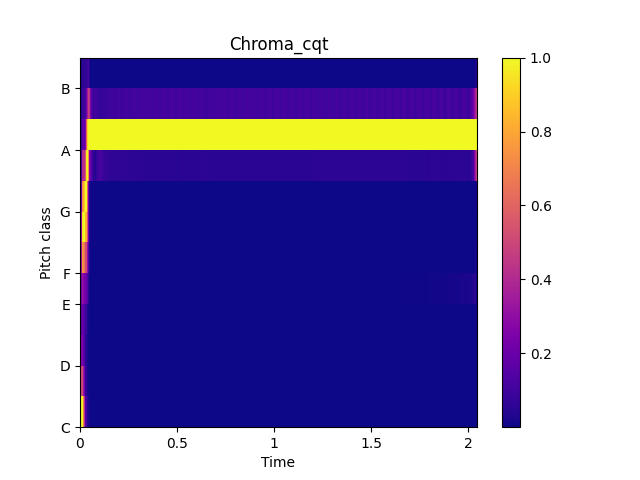audioflux.chroma_cqt
- audioflux.chroma_cqt(X, chroma_num=12, num=84, samplate=32000, low_fre=32.70319566257483, bin_per_octave=12, factor=1.0, thresh=0.01, window_type=WindowType.HANN, slide_length=None, normal_type=SpectralFilterBankNormalType.AREA, is_scale=True)
Constant-Q chromagram
Note
We recommend using the CQT class, you can use it more flexibly and efficiently.
- Parameters
- X: np.ndarray [shape=(…, n)]
audio time series.
- chroma_num: int
Number of chroma bins to generate.
- num: int
Number of frequency bins to generate, starting at low_fre.
Usually:
num = octave * bin_per_octave, default: 84 (7 * 12)- samplate: int:
Sampling rate of the incoming audio.
- low_fre: float
Lowest frequency. default: 32.703(C1)
- bin_per_octave: int
Number of bins per octave.
- factor: float
Factor value
- thresh: float
Thresh value
- window_type: WindowType
Window type for each frame.
See:
type.WindowType- slide_length: int
Window sliding length.
- normal_type: SpectralFilterBankNormalType
Spectral filter normal type. It determines the type of normalization.
- is_scale: bool
Whether to use scale.
- Returns
- out: np.ndarray [shape=(…, chroma_num, time)]
The matrix of CHROMA_CQT
See also
Examples
Read 220Hz audio data
>>> import audioflux as af >>> audio_path = af.utils.sample_path('220') >>> audio_arr, sr = af.read(audio_path)
Extract chroma_cqt data
>>> chroma_arr = af.chroma_cqt(audio_arr, samplate=sr)
Show spectrogram plot
>>> import matplotlib.pyplot as plt >>> from audioflux.display import fill_spec >>> import numpy as np >>> >>> # calculate x-coords >>> audio_len = audio_arr.shape[-1] >>> x_coords = np.linspace(0, audio_len/sr, chroma_arr.shape[-1] + 1) >>> >>> fig, ax = plt.subplots() >>> img = fill_spec(chroma_arr, axes=ax, >>> x_coords=x_coords, >>> x_axis='time', y_axis='chroma', >>> title='Chroma_cqt') >>> fig.colorbar(img, ax=ax)
